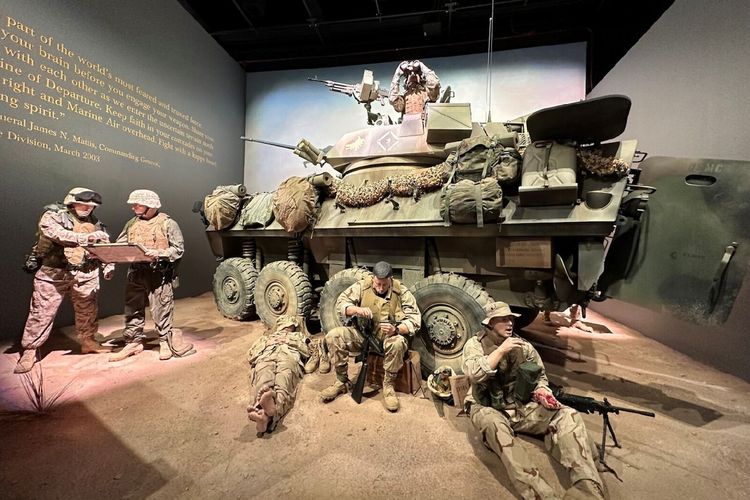New Museum Addition Captures Realism and Legacy of Post ...

A museum's new exhibits feature hundreds of artifacts from all major Marine Corps operations from the end of the Vietnam War through operations in Iraq and Afghanistan.
Keil Gentry, director of the National Museum of the Marine Corps in Quantico, Virginia, said the purpose of the museum and the new exhibits is to honor the selfless service of Marines, many of whom were killed or wounded.
"We want to reinvigorate the spirits of today's Marines and inspire young men and women to be the next generation of Marines," he said.
The new, 20,000-square-foot exhibits open to the public on Oct. 6.
Highlights of the exhibits include the M198 howitzer that fired the first shot in the Persian Gulf War; an amphibious assault vehicle coming up on the beach from the ocean; and Marines meeting with tribal elders in Afghanistan.
Gentry said all of the figures were cast from real Marines and Navy corpsmen, a process that takes about four hours. He said a mold was cast for his life-size figure. Two straws were placed in his nose so he could breathe while two layers of silicone were painted over his entire body.
Retired Marine Corps Maj. David McGrath said he is one of the Marines depicted in a new display. Then a captain, McGrath was in Helmand Province, Afghanistan, when his mine-resistant, ambush-protected vehicle hit an improvised explosive device on Oct. 10, 2010.
The turret gunner was ejected from the front hood. McGrath immediately got on his radio to call for medical evacuation for the wounded gunner, who was being treated by a corpsman. Everyone in the vehicle survived, he said.
{{slideNumber}} of {{numSlides}}
{{slideNumber}}/{{numSlides}} {{slideTitle}} - {{slideCaption}}
{{slideInfo.slideNumber}}/{{numSlides}} {{slideInfo.slideTitle}} - {{slideInfo.slideCaption}}
McGrath aided the curator in recreating the scene, including the bomb crater and corpsman treating the wounded gunner. The vehicle in the exhibit is the exact one he was riding in. In another exhibit, female Marines stationed at entry control points in Iraq and Afghanistan.
Marine Corps veterans Saje Mrowinski and Riane Moser were lance corporals in Afghanistan from 2010 to 2011.
They said female Marines were invaluable in engaging local women because their culture dictated that men and women cannot interact. Besides identity and weapons checks, they gained valuable intelligence from local residents.
Besides checkpoints, Mrowinski and Moser said they also went on combat patrols and even cleared buildings of suspected insurgents. They spoke during a media preview of the new exhibits on Wednesday.
"These exhibits stand as an enduring tribute to those who have supported, fought and sacrificed in the name of national security, the defense of our allies, and the preservation of the American way of life," said Lt. Gen. Benjamin T. Watson, commander of the Marine Corps Training and Education Command.
"We welcome visitors from around the globe to our museum, where they can witness the faces, uniforms, equipment, and hear the stories of those who served with tireless dedication and honorable courage."
The museum opened on Nov. 10, 2006, the 231st birthday of the Marine Corps. Since then, over 7 million people have visited, including Marines and their families, veterans, students, military historians and the general public. Admission and parking are free.









































